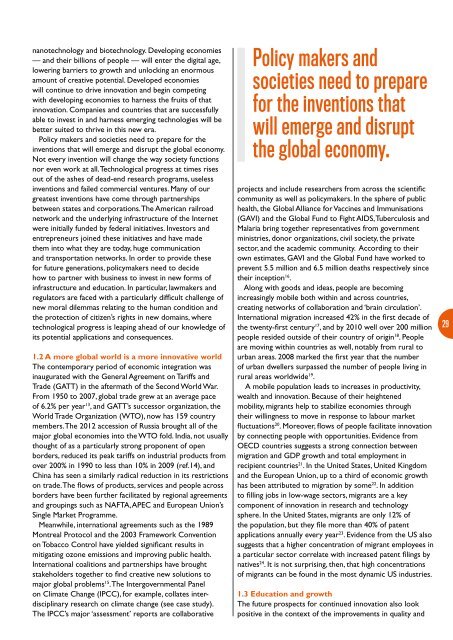14-1190b-innovation-managing-risk-evidence
14-1190b-innovation-managing-risk-evidence
14-1190b-innovation-managing-risk-evidence
Create successful ePaper yourself
Turn your PDF publications into a flip-book with our unique Google optimized e-Paper software.
nanotechnology and biotechnology. Developing economies<br />
— and their billions of people — will enter the digital age,<br />
lowering barriers to growth and unlocking an enormous<br />
amount of creative potential. Developed economies<br />
will continue to drive <strong>innovation</strong> and begin competing<br />
with developing economies to harness the fruits of that<br />
<strong>innovation</strong>. Companies and countries that are successfully<br />
able to invest in and harness emerging technologies will be<br />
better suited to thrive in this new era.<br />
Policy makers and societies need to prepare for the<br />
inventions that will emerge and disrupt the global economy.<br />
Not every invention will change the way society functions<br />
nor even work at all. Technological progress at times rises<br />
out of the ashes of dead-end research programs, useless<br />
inventions and failed commercial ventures. Many of our<br />
greatest inventions have come through partnerships<br />
between states and corporations. The American railroad<br />
network and the underlying infrastructure of the Internet<br />
were initially funded by federal initiatives. Investors and<br />
entrepreneurs joined these initiatives and have made<br />
them into what they are today, huge communication<br />
and transportation networks. In order to provide these<br />
for future generations, policymakers need to decide<br />
how to partner with business to invest in new forms of<br />
infrastructure and education. In particular, lawmakers and<br />
regulators are faced with a particularly difficult challenge of<br />
new moral dilemmas relating to the human condition and<br />
the protection of citizen’s rights in new domains, where<br />
technological progress is leaping ahead of our knowledge of<br />
its potential applications and consequences.<br />
1.2 A more global world is a more innovative world<br />
The contemporary period of economic integration was<br />
inaugurated with the General Agreement on Tariffs and<br />
Trade (GATT) in the aftermath of the Second World War.<br />
From 1950 to 2007, global trade grew at an average pace<br />
of 6.2% per year 13 , and GATT’s successor organization, the<br />
World Trade Organization (WTO), now has 159 country<br />
members. The 2012 accession of Russia brought all of the<br />
major global economies into the WTO fold. India, not usually<br />
thought of as a particularly strong proponent of open<br />
borders, reduced its peak tariffs on industrial products from<br />
over 200% in 1990 to less than 10% in 2009 (ref.<strong>14</strong>), and<br />
China has seen a similarly radical reduction in its restrictions<br />
on trade. The flows of products, services and people across<br />
borders have been further facilitated by regional agreements<br />
and groupings such as NAFTA, APEC and European Union’s<br />
Single Market Programme.<br />
Meanwhile, international agreements such as the 1989<br />
Montreal Protocol and the 2003 Framework Convention<br />
on Tobacco Control have yielded significant results in<br />
mitigating ozone emissions and improving public health.<br />
International coalitions and partnerships have brought<br />
stakeholders together to find creative new solutions to<br />
major global problems 15 . The Intergovernmental Panel<br />
on Climate Change (IPCC), for example, collates interdisciplinary<br />
research on climate change (see case study).<br />
The IPCC’s major ‘assessment’ reports are collaborative<br />
Policy makers and<br />
societies need to prepare<br />
for the inventions that<br />
will emerge and disrupt<br />
the global economy.<br />
projects and include researchers from across the scientific<br />
community as well as policymakers. In the sphere of public<br />
health, the Global Alliance for Vaccines and Immunisations<br />
(GAVI) and the Global Fund to Fight AIDS, Tuberculosis and<br />
Malaria bring together representatives from government<br />
ministries, donor organizations, civil society, the private<br />
sector, and the academic community. According to their<br />
own estimates, GAVI and the Global Fund have worked to<br />
prevent 5.5 million and 6.5 million deaths respectively since<br />
their inception 16 .<br />
Along with goods and ideas, people are becoming<br />
increasingly mobile both within and across countries,<br />
creating networks of collaboration and ‘brain circulation’.<br />
International migration increased 42% in the first decade of<br />
the twenty-first century 17 , and by 2010 well over 200 million<br />
people resided outside of their country of origin 18 . People<br />
are moving within countries as well, notably from rural to<br />
urban areas. 2008 marked the first year that the number<br />
of urban dwellers surpassed the number of people living in<br />
rural areas worldwide 19 .<br />
A mobile population leads to increases in productivity,<br />
wealth and <strong>innovation</strong>. Because of their heightened<br />
mobility, migrants help to stabilize economies through<br />
their willingness to move in response to labour market<br />
fluctuations 20 . Moreover, flows of people facilitate <strong>innovation</strong><br />
by connecting people with opportunities. Evidence from<br />
OECD countries suggests a strong connection between<br />
migration and GDP growth and total employment in<br />
recipient countries 21 . In the United States, United Kingdom<br />
and the European Union, up to a third of economic growth<br />
has been attributed to migration by some 22 . In addition<br />
to filling jobs in low-wage sectors, migrants are a key<br />
component of <strong>innovation</strong> in research and technology<br />
sphere. In the United States, migrants are only 12% of<br />
the population, but they file more than 40% of patent<br />
applications annually every year 23 . Evidence from the US also<br />
suggests that a higher concentration of migrant employees in<br />
a particular sector correlate with increased patent filings by<br />
natives 24 . It is not surprising, then, that high concentrations<br />
of migrants can be found in the most dynamic US industries.<br />
1.3 Education and growth<br />
The future prospects for continued <strong>innovation</strong> also look<br />
positive in the context of the improvements in quality and<br />
29


